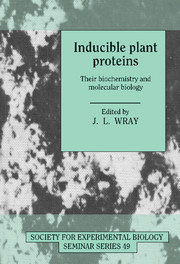Book contents
- Frontmatter
- Contents
- List of Contributors
- Preface
- Metal-binding proteins and metal-regulated gene expression in higher plants
- Phosphate starvation inducible enzymes and proteins in higher plants
- Nitrate reduction in higher plants: molecular approaches to function and regulation
- Inducibility of the glutamine synthetase gene family in Phaseolus vulgaris L.
- Expression and manipulation of genes involved in phenylpropanoid biosynthesis
- Biochemistry and molecular biology of CAM
- ABA- and GA-responsive gene expression
- Regulation of gene expression, ethylene synthesis and ripening in transgenic tomatoes
- Induction of nodulin genes and root nodule symbiosis
- Systemic acquired resistance: an inducible defence mechanism in plants
- Biochemistry and molecular biology of the anaerobic response
- The heat shock response in transgenic plants: the use of chimaeric heat shock genes
- Biochemistry and molecular biology of cold-inducible enzymes and proteins in higher plants
- GBF-1, GBF-2 and GBF-3: three Arabidopsis b-Zip proteins that interact with the light-regulated rbcS-1A promoter
- Index
Phosphate starvation inducible enzymes and proteins in higher plants
Published online by Cambridge University Press: 06 July 2010
- Frontmatter
- Contents
- List of Contributors
- Preface
- Metal-binding proteins and metal-regulated gene expression in higher plants
- Phosphate starvation inducible enzymes and proteins in higher plants
- Nitrate reduction in higher plants: molecular approaches to function and regulation
- Inducibility of the glutamine synthetase gene family in Phaseolus vulgaris L.
- Expression and manipulation of genes involved in phenylpropanoid biosynthesis
- Biochemistry and molecular biology of CAM
- ABA- and GA-responsive gene expression
- Regulation of gene expression, ethylene synthesis and ripening in transgenic tomatoes
- Induction of nodulin genes and root nodule symbiosis
- Systemic acquired resistance: an inducible defence mechanism in plants
- Biochemistry and molecular biology of the anaerobic response
- The heat shock response in transgenic plants: the use of chimaeric heat shock genes
- Biochemistry and molecular biology of cold-inducible enzymes and proteins in higher plants
- GBF-1, GBF-2 and GBF-3: three Arabidopsis b-Zip proteins that interact with the light-regulated rbcS-1A promoter
- Index
Summary
Introduction
In this chapter, I discuss the current state of knowledge about the biochemistry and molecular biology of phosphate starvation inducible (psi) enzymes and proteins in higher plants. Special attention will be paid to the excreted phosphate starvation inducible (epsi, pronounced ee Ψ) acid phosphatase (APase) of higher plants. A significant amount of data now exists to support the theory that the epsi-APase, an epsi-RNase, several intracellular RNases and other proteins of unknown function form a family of co-induced proteins that act, at least in part, as a phosphate starvation rescue mechanism for higher plants. In addition, we have conducted experiments to show that some of these proteins can apparently affect phosphate use-efficiency metabolism under non-starvation conditions. While crucial experiments remain to be done, our data further suggest that the epsi-APase genes as well as genes for other psi proteins can be regulated at the mRNA level (possibly by transcriptional activation). We have proposed, as a working model, that these psi genes are part of the higher plant pho stimulon and may be co-regulated by the same trans-acting element(s) to form a pho regulon (Goldstein et al., 1989a).
Phosphorus is an essential nutrient for all cells. For organisms that absorb their mineral nutrients directly from the external medium, ionic inorganic phosphate (Pi, usually H2PO4− or HPO42−) is the preferentially absorbed form of phosphorus. A macronutrient based on its contribution to biomass, Pi is one of the least available mineral nutrients in many environments.
- Type
- Chapter
- Information
- Inducible Plant ProteinsTheir Biochemistry and Molecular Biology, pp. 25 - 44Publisher: Cambridge University PressPrint publication year: 1992
- 22
- Cited by



